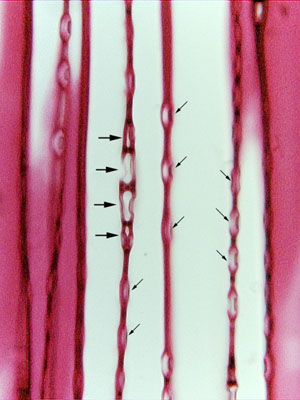 Fig.
15.2-4. Tangential section of white pine
wood. This high magnification shows a
small ray only four cells tall (large, horizontal arrows). The cells
are small and the walls appear bowed inward because almost the entire wall
between each ray cell and the adjacent axial tracheid consists of a large
circular bordered pit. The small, diagonal arrows point to circular bordered
pits (more correctly, pairs of such pits) that connect adjacent axial tracheids.
The ray cells are so small it would be easy to mistake one for a single circular
bordered pit pair. Notice that the circular bordered pits are in the radial
walls, the walls that come straight out at us as we look toward the center of
the tree.
Fig.
15.2-4. Tangential section of white pine
wood. This high magnification shows a
small ray only four cells tall (large, horizontal arrows). The cells
are small and the walls appear bowed inward because almost the entire wall
between each ray cell and the adjacent axial tracheid consists of a large
circular bordered pit. The small, diagonal arrows point to circular bordered
pits (more correctly, pairs of such pits) that connect adjacent axial tracheids.
The ray cells are so small it would be easy to mistake one for a single circular
bordered pit pair. Notice that the circular bordered pits are in the radial
walls, the walls that come straight out at us as we look toward the center of
the tree.